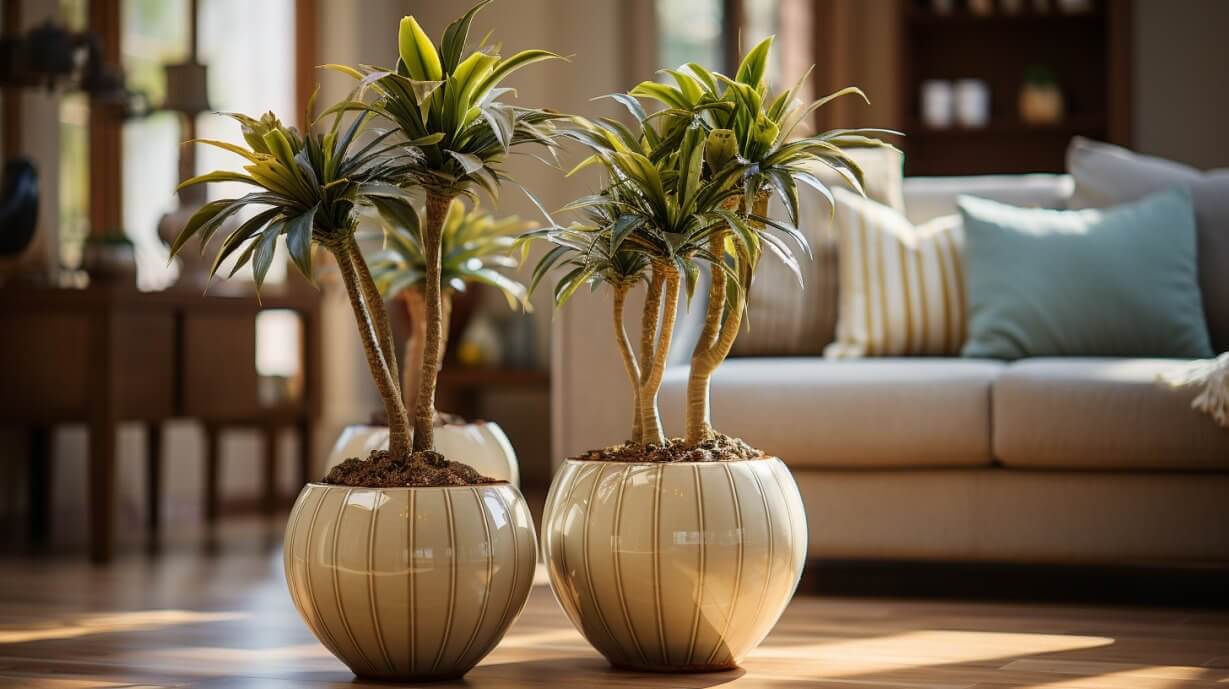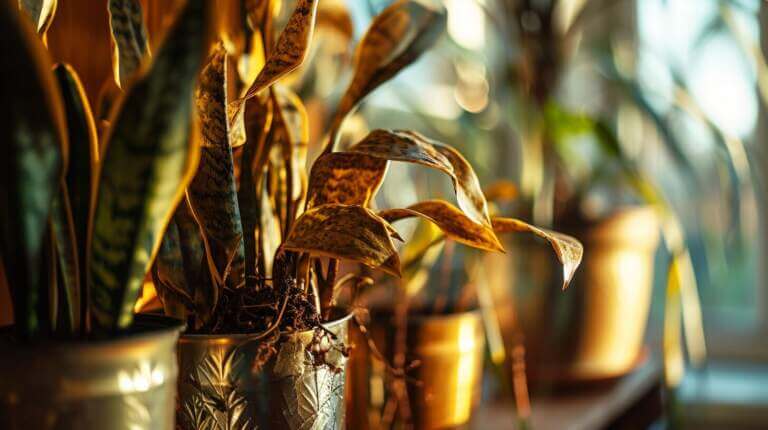How to Care for Dracaena Marginata: Grow a Healthy Dragon Tree Indoor Houseplants
Discover how to care for dracaena marginata, your personal dragon tree indoor houseplant, and learn how to grow a healthy and thriving indoor houseplant. Madagascar dragon tree is one of the easiest plants to care for by inexperienced plant parents.
Dracaena marginata, also known as the dragon tree, is a low-maintenance attractive plant that is perfect for beginners. It thrives in low light and can tolerate neglect on the watering front. The plant should be grown in a draught-free spot with bright, indirect light. It should be watered when the top half of the soil is dry to avoid overwatering. Dragon trees should be kept out of direct sunlight to prevent leaf scorching. The leaves should be wiped occasionally to remove dust, and any dead or brown leaves should be removed. Dragon trees can be propagated by taking stem cuttings and rooting them in water. The potted plant should be repotted every three to four years into a well-draining, peat-free potting soil. Fertilize the plant every fourth time you water during the growing season with a general house plant fertilizer. Dragon trees are susceptible to pests like red spider mite, scale insects, and thrips, which can be controlled by increasing humidity and using soap spray. Overall, with proper care, a dragon tree can be an easiest indoor plants to grow.
Key Takeaways:
- Dracaena marginata, also known as the madagascar dragon tree is native to madagascar is one of those easy to care, plant to grow.
- Place your dragon tree in a draught-free spot with bright, indirect light.
- Water your dragon tree when the top half of the soil is dry to avoid overwatering.
- Remove dust from the leaves and prune any dead or brown leaves to maintain the plant’s appearance and health.
- Propagate your dragon tree by taking stem cuttings and rooting them in water.
Finding the Perfect Spot for Your Dragon Tree
When it comes to caring for your dragon tree, finding the perfect spot with the right amount of light and humidity is crucial. Dracaena marginata, also known as the dragon tree, is a low-maintenance plant that thrives in low light conditions and can tolerate neglect on the watering front. To ensure the health and well-being of your dragon tree, here are some key factors to consider when choosing the ideal location for your plant.
- Indoor Environment: Dragon trees are best suited for indoors environments due to their sensitivity to cold temperatures. They prefer temperatures between 60-80°F (15-27°C) and should be protected from drafts.
- Light Requirements: While they thrive in low light conditions, it is important to provide your dragon tree with bright, indirect light. Placing the plant near a north or east-facing window is ideal. Avoid direct sunlight as it can cause leaf scorching.
- Humidity: Dragon trees can tolerate average household humidity levels, but higher humidity can promote better growth and prevent pest infestations. To increase humidity, you can place the plant on a tray filled with pebbles and water or use a humidifier.
Remember to periodically wipe the plant’s leaves with a damp cloth to remove dust and keep them looking healthy. If you notice any dead or brown leaves, be sure to remove them promptly to maintain the plant’s overall appearance.
How to Monitor Light Levels
It can be challenging to determine if your dragon tree is receiving the right amount of light. However, a simple trick you can use is to observe the color of the plant’s leaves. If the leaves are dark green, it means the plant is not receiving enough light. On the other hand, if the leaves are pale or yellowish, it may indicate that the light levels are too intense. Adjust the plant’s placement accordingly to achieve the optimal light conditions for your dragon tree.
By carefully considering these factors and providing the right conditions, you can ensure that your dragon tree thrives and adds a touch of natural beauty to your indoor space. In the next section, we will explore how to properly water and prune your dragon tree to promote its health and growth.
| Light Level | Description |
|---|---|
| Low Light | Indirect light, such as a few feet away from a north-facing window |
| Bright Light | Indirect light, but not in direct line of sight from a south or west-facing window |
| Low Light | Indirect light, such as a few feet away from a north-facing window |
| Indirect Light | Light that is filtered through curtains or blinds, providing a soft glow |
Watering and Pruning Your Dragon Tree
Proper watering and pruning are essential for keeping your dragon tree healthy and thriving. Dracaena marginata, also known as the dragon tree, is a low-maintenance plant that can tolerate neglect on the watering front. This makes it perfect for beginners or busy individuals who may not have time for frequent watering.
When it comes to watering your dragon tree, it’s important to find the right balance. Overwatering can lead to root rot, while underwatering can cause the leaves to turn brown and dry out. To avoid these issues, water your dragon tree when the top half of the soil feels dry. Stick your finger about an inch into the soil – if it feels damp, hold off on watering. Be sure to use a well-draining potting mix to prevent water from pooling at the bottom of the pot.
Pruning is another important aspect of caring for your dragon tree. Regular pruning helps maintain the plant’s shape and remove any dead or damaged leaves. Use clean, sharp pruning shears to make clean cuts and reduce the risk of disease. If you notice any brown or yellow leaves, simply trim them off to promote new growth. Repotting your dragon tree every three to four years is also recommended to ensure it has enough room to grow and thrive.
| Watering Tips: | Pruning Tips: |
|---|---|
| – Water when the top half of the soil is dry | – Use clean, sharp pruning shears |
| – Use well-draining potting mix | – Trim off any dead or damaged leaves |
| – Avoid overwatering to prevent root rot | – Repot every three to four years |
| – Watch for signs of underwatering (browning and drying leaves) |
By following these watering and pruning tips, you can ensure that your dragon tree remains healthy and vibrant. Remember to monitor the soil moisture and adjust your watering frequency as needed. Regular pruning will help maintain its shape and remove any signs of stress or damage. With proper care, your dragon tree will continue to be a beautiful and thriving addition to your indoor plant collection.
Preventing and Treating Common Problems
While caring for your dragon tree, it’s important to be aware of common problems that can affect its health and take appropriate measures to prevent or treat them. Pests like red spider mites, scale insects, and thrips can be particularly troublesome for these plants. To combat these pests, you can increase the humidity around the plant by placing a tray of water nearby or using a humidifier. Additionally, you can use a soap spray, such as a mixture of mild dish soap and water, to control and eliminate pests. Thoroughly coat the leaves and stems of the dragon tree with the soap spray, being sure to reach the undersides of the leaves where pests often hide. Repeat this process as needed until the infestation is under control.
Another common issue that may arise is root rot, which is often caused by overwatering or poor drainage. To prevent root rot, it’s important to ensure that the potting mix is well-draining and that excess water can flow freely out of the pot. Avoid letting the plant sit in standing water, as this can lead to root rot. If you suspect root rot, gently remove the plant from its pot and inspect the roots. Healthy roots should be firm and white, while rotted roots will appear dark, mushy, or slimy. If you find rotted roots, trim them off with clean, sharp scissors and replant the dragon tree in fresh, well-draining soil.
Brown leaf tips and yellow leaves are also common issues that can occur with dragon trees. Brown leaf tips are typically caused by underwatering or low humidity, while yellow leaves can indicate overwatering or nutrient deficiencies. To prevent brown leaf tips, make sure to maintain adequate humidity levels around the plant and water it regularly. If you notice brown tips on the leaves, simply trim off the affected areas using clean, sharp scissors. Yellow leaves, on the other hand, may require adjusting your watering schedule or providing the plant with a balanced house plant fertilizer. A fertilizer specifically formulated for indoor plants can help replenish essential nutrients and promote healthy growth. Remember to follow the instructions on the fertilizer packaging for best results.
| Problem | Cause | Solution |
|---|---|---|
| Brown leaf tips | Underwatering or low humidity | Maintain adequate humidity levels and water regularly. Trim affected tips. |
| Yellow leaves | Overwatering or nutrient deficiencies | Adjust watering schedule and use a balanced house plant fertilizer. |
| Root rot | Overwatering or poor drainage | Ensure well-draining soil and avoid excessive watering. |
| Pests (red spider mites, scale insects, thrips) | Poor humidity and lack of pest control | Increase humidity and use a soap spray to control pests. |
Propagating and Fertilizing Your Dragon Tree
Learn how to propagate and fertilize your dragon tree to expand your indoor plant collection and ensure its continued vitality.
Propagating Dracaena Marginata is a fun and rewarding way to grow more plants. You can propagate your dragon tree by taking stem cuttings. Simply choose a healthy stem and cut it just below a leaf node. Remove the lower leaves and place the cutting in a jar of water. Make sure to change the water every few days to keep it fresh. In a few weeks, you’ll start to see roots forming. Once the roots are about 2 inches long, you can transfer the cutting to a pot filled with a well-draining, peat-free potting mix.
Fertilizing your dragon tree is crucial for its growth and overall health. Use a general house plant fertilizer and follow the instructions on the package. During the growing season, fertilize your dragon tree every fourth time you water. This will provide it with the necessary nutrients to thrive. Be sure to dilute the fertilizer to the recommended strength to avoid burn. Remember to water your dragon tree before applying the fertilizer to prevent any root damage.
By propagating and fertilizing your dragon tree, you can create a lush and vibrant indoor plant collection. Enjoy the process of watching your cuttings grow roots and develop into new plants. With proper care and attention, your dragon tree will continue to bring beauty and life into your home.
FAQ
How much light does a madagascar dragon tree need?
Dragon trees thrive in bright, indirect light. They can also tolerate low light conditions, making them a versatile indoor plant.
How often to water your dragon tree(dracaena marginata)?
Water your dragon tree when the top half of the soil is dry. Avoid overwatering, as this can lead to root rot. Underwatering is preferable to overwatering for this plant.
Should I remove dead or brown leaves from my dragon tree?
Yes, it’s important to remove any dead or brown leaves from your dragon tree. This helps maintain the plant’s overall health and appearance.
How do I propagate a dragon tree plant?
Dragon trees can be propagated by taking stem cuttings and rooting them in water. This is an easy and effective way to propagate the plant and create new ones.
How often should I repot my dragon tree?
It is recommended to repot your dragon tree every three to four years. Use a well-draining, peat-free potting mix to ensure proper drainage for the plant.
How do I fertilize my dragon tree?
Fertilize your dragon tree every fourth time you water during the growing season. Use a general house plant fertilizer to provide the necessary nutrients for healthy growth.
How can I prevent and treat pests on my dragon tree?
Common pests like red spider mite, scale insects, and thrips can be controlled by increasing humidity around the plant and using a soap spray to remove them. Regularly wiping the leaves to remove dust also helps prevent pest infestations.
Can I keep my dragon tree in direct sunlight?
Dragon trees do best when the plant is out of direct sunlight to prevent leaf scorching. Bright, indirect light is ideal for this plant’s health and growth. In lower light situations will grow slower and produce smaller dragon plant foliage.







